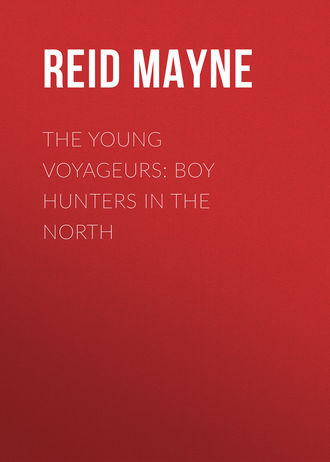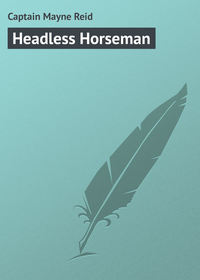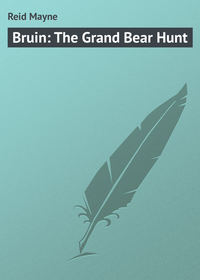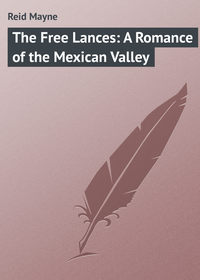 полная версия
полная версияThe Young Voyageurs: Boy Hunters in the North
“Now,” remarked François, “if we only had a cup of coffee and a glass of wine, we might say that we had dined in fashionable style.”
“I think,” replied Lucien, “we are better without the wine, and as for the other I cannot give you that, but I fancy I can provide you with a cup of tea if you only allow me a little time.”
“Tea!” screamed François; “why, there’s not a leaf of tea nearer than China; and for the sugar, not a grain within hundreds of miles!”
“Come, Frank,” said Lucien, “nature has not been so ungenerous here, – even in such luxuries as tea and sugar. Look yonder! You see those large trees with the dark-coloured trunks. What are they?”
“Sugar-maples,” replied François.
“Well,” said Lucien, “I think even at this late season we might contrive to extract sap enough from them to sweeten a cup of tea. You may try, while I go in search of the tea-plant.”
“Upon my word, Luce, you are equal to a wholesale grocery. Very well. Come, Basil, we’ll tap the maples; let the captain go with Luce.”
The boys, separating into pairs, walked off in different directions. Lucien and his companion soon lighted upon the object of their search in the same wet bottom where they had procured the Heracleum. It was a branching shrub, not over two feet in height, with small leaves of a deep green colour above, but whitish and woolly underneath. It is a plant well-known throughout most of the Hudson’s Bay territory by the name of “Labrador tea-plant;” and is so called because the Canadian voyageurs, and other travellers through these northern districts, often drink it as tea. It is one of the Ericaceae, or heath tribe, of the genus Ledum– though it is not a true heath, as, strange to say, no true heath is found upon the continent of America.
There are two kinds of it known, – the “narrow-leafed” and “broad-leafed;” and the former makes the best tea. But the pretty white flowers of the plant are better for the purpose than the leaves of either variety; and these it was that were now gathered by Lucien and Norman. They require to be dried before the decoction is made; but this can be done in a short time over a fire; and so in a short time it was done, Norman having parched them upon heated stones. Meanwhile Basil and François had obtained the sugar-water, and Lucien having washed his soup-kettle clean, and once more made his boiling stones red-hot, prepared the beverage; and then it was served out in the tin cup, and all partook of it. Norman had drunk the Labrador tea before, and was rather fond of it, but his Southern cousins did not much relish it. Its peculiar flavour, which somewhat resembles rhubarb, was not at all to the liking of François. All, however, admitted that it produced a cheering effect upon their spirits; and, after drinking it, they felt in that peculiarly happy state of mind which one experiences after a cup of the real “Bohea.”
Chapter Seventeen.
The Marmots of America
From such a luxurious dinner you may suppose that our young voyageurs lived in prime style. But it was not always so. They had their fasts as well as feasts. Sometimes for days they had nothing to eat but the jerked deer-meat. No bread – no beer – no coffee, nothing but water – dry venison and water. Of course, this is food enough for a hungry man; but it can hardly be called luxurious living. Now and then a wild duck, or a goose, or perhaps a young swan, was shot; and this change in their diet was very agreeable. Fish were caught only upon occasions, for often these capricious creatures refused François’ bait, however temptingly offered. After three weeks’ coasting the Lake, they reached the Saskatchewan, and turning up that stream, now travelled in a due westerly direction. At the Grand Rapids, near the mouth of this river, they were obliged to make a portage of no less than three miles, but the magnificent view of these “Rapids” fully repaid them for the toil they underwent in passing them.
The Saskatchewan is one of the largest rivers in America, being full 1600 miles in length, from its source in the Rocky Mountains to its débouchure, under the name of the “Nelson River,” in Hudson’s Bay. For some distance above Lake Winnipeg, the country upon its banks is well wooded. Farther up, the river runs through dry sandy prairies that extend westward to the foot-hills of the Rocky Mountains. Many of these prairies may be properly called “deserts.” They contain lakes as salt as the ocean itself, and vast tracts – hundreds of square miles in extent – where not a drop of water is to be met with. But the route of our voyageurs did not lie over these prairies. It was their intention, after reaching Cumberland House, to turn again in a northerly direction.
One evening, when within two days’ journey of the Fort, they had encamped upon the bank of the Saskatchewan. They had chosen a beautiful spot for their camp, where the country, swelling into rounded hills, was prettily interspersed with bushy copses of Amelanchiers, and Rosa blanda, whose pale red flowers were conspicuous among the green leaves, and filled the air with a sweet fragrance, that was wafted to our voyageurs upon the sunny breeze. The ground was covered with a grassy sward enamelled by the pink flowers of the Cleome, and the deeper red blossoms of the beautiful wind-flower (Anemone). Upon that day our travellers had not succeeded in killing any game, and their dinner was likely to consist of nothing better than dry venison scorched over the coals. As they had been travelling all the morning against a sharp current, and, of course, had taken turn about at the paddles, they all felt fatigued, and none of them was inclined to go in search of game. They had flung themselves down around the fire, and were waiting until the venison should be broiled for dinner.
The camp had been placed at the foot of a tolerably steep hill, that rose near the banks of the river. There was another and higher hill facing it, the whole front of which could be seen by our travellers as they sat around their fire. While glancing their eyes along its declivity, they noticed a number of small protuberances or mounds standing within a few feet of each other. Each of them was about a foot in height, and of the form of a truncated cone – that is, a cone with its top cut off, or beaten down.
“What are they?” inquired François.
“I fancy,” answered Lucien, “they are marmot-houses.”
“They are,” affirmed Norman; “there are plenty of them in this country.”
“Oh! marmots!” said François. “Prairie-dogs, you mean? – the same we met with on the Southern prairies?”
“I think not,” replied Norman: “I think the prairie-dogs are a different sort. Are they not, Cousin Luce?”
“Yes, yes,” answered the naturalist; “these must be a different species. There are too few of them to be the houses of prairie-dogs. The ‘dogs’ live in large settlements, many hundreds of them in one place; besides, their domes are somewhat different in appearance from these. The mounds of the prairie-dogs have a hole in the top or on one side. These, you see, have not. The hole is in the ground beside them, and the hill is in front, made by the earth taken out of the burrow, just as you have seen it at the entrance of a rat’s hole. They are marmots, I have no doubt, but of a different species from the prairie-dog marmots.”
“Are there not many kinds of marmots in America? I have heard so,” said François.
This question was of course addressed to Lucien.
“Yes,” answered he. “The fauna of North America is peculiarly rich in species of these singular animals. There are thirteen kinds of them, well-known to naturalists; and there are even some varieties in these thirteen kinds that might almost be considered distinct species. I have no doubt, moreover, there are yet other species which have not been described. Perhaps, altogether, there are not less than twenty different kinds of marmots in North America. As only one or two species are found in the settled territories of the United States, it was supposed, until lately, that there were no others. Latterly the naturalists of North America have been very active in their researches, and no genus of animals has rewarded them so well as the marmots – unless, perhaps, it may be the squirrels. Almost every year a new species of one or the other of these has been found – mostly inhabiting the vast wilderness territories that lie between the Mississippi and the Pacific Ocean.
“As regards the marmots, the closet-naturalists, as usual, have rendered their history as complicated and difficult to be understood as possible. They have divided them into several genera, because one kind happens to have a larger tubercle upon its tooth than another, or a little more curving in its claws, or a shorter tail. It is true that in the thirteen species some differ considerably from the others in size, colour, and other respects. Yet, for all that, there is such an identity, if I may so express it, about the mode of life, the food, the appearance, and habits of all the thirteen, that I think it is both absurd and ill-judged to render the study of them more difficult, by thus dividing them into so many genera. They are all marmots, that is what they are; and why confound the study of them by calling them spermophiles and arctomys, and such-like hard names?”
“I quite agree with you, Luce,” said the hunter, Basil, who, although not averse to the study of natural history (all hunters, I believe, love it more or less), had no great opinion of the closet-naturalists and “babblers about teeth,” as he contemptuously called them.
“When a family of animals,” continued Lucien, “contains a great many species, and these species differ widely from each other, I admit that it may then be convenient and useful to class them into genera, and sometimes even sub-genera; but, on the other hand, when there are only a few species, and these closely allied to each other, I think nothing can be more ridiculous than this dividing and subdividing, and giving such unpronounceable names to them. It is this that renders the study difficult, because even the committing to memory such a string of unmeaning phrases is of itself no easy task. Take, for example, such a phrase as ‘Arctomys spermophilus Rickardsonii,’ which, although nearly a yard long, means simply the ‘tawny marmot.’ Do not mistake me,” continued Lucien; “I do not object to the use of the Greek or Latin phraseology used in such cases. Some universal language must be adopted, so that the naturalists of different countries may understand each other. But then this language should, when translated, describe the animal, by giving some of its characteristics, and thus have a meaning. On the contrary, it usually, when put into plain English, gives us only the name – often a clumsy and unpronounceable German one – of some obscure friend of the author, or, as is not unfrequently the case, some lordly patron for whom your closet-naturalist entertains a flunkeyish regard, and avails himself of this means of making it known to his Maecenas. In my opinion,” continued Lucien, warming with the enthusiasm of a true naturalist, “it is a most impertinent interference with the beautiful things of Nature – her birds and quadrupeds, her plants and flowers – to couple them with the names of kings, princes, lords, and lordlings, who chance to be the local gods of some closet-naturalist. It is these catalogue-makers who generally multiply synonymes so as to render science unintelligible. Sitting in their easy-chairs they know little or nothing of the habits of the animals about which they write; and therefore, to write something original, they multiply names, and give measurements ad infinitum, and this among them constitutes a science. I do not, of course, include among these the man whose name is given – Richardson. No; he was a true naturalist, who travelled and underwent hardships to earn the high name which he bears and so well deserves.”
“Brother Luce,” said Basil, “you grow excited upon this subject, and that is something of a rarity to see. I agree with you, however, in all you have said. Previous to our leaving home I read several books upon natural history. They were the works of distinguished closet-naturalists. Well, I found that all the information they contained about the animals of these Northern regions – at least, all that could be called information– I had read somewhere before. After thinking for a while I recollected where. It was in the pages of the traveller Hearne – a man who, among these scientific gentlemen, is considered only in the light of a rude traveller, and not deserving the name of naturalist. Hearne journeyed to the Arctic Sea so early as the year 1771; and to him the world is indebted for their first knowledge of the fact that there was no strait across the Continent south of the seventieth parallel of latitude.”
“Yes,” said Lucien, “he was sent out by the Hudson’s Bay Company, perhaps more scantily furnished than any explorer ever was before. He underwent the most dreadful hardships and perils, and has left behind him an account of the inhabitants and natural history of these parts, so full and so truthful, that it has not only stood the test of subsequent observation, but the closet-naturalists have added but little to it ever since. Most of them have been satisfied with giving just what poor Hearne had gathered – as, in fact, they knew nothing more, and could not, therefore, add anything. Some of them have quoted his own words, and given him the credit of his vast labour; while others have endeavoured to pass off Hearne’s knowledge as their own, by giving a slightly altered paraphrase of his language. This sort of thing,” said Lucien, “makes me indignant.”
“It’s downright mean,” interposed Norman. “All of us in this country have heard of Hearne. He was a right hardy traveller, and no mistake about it.”
“Well, then,” said Lucien, cooling down, and resuming the subject of the marmots, “these little animals seem to form a link between the squirrels and rabbits. On the side of the squirrels they very naturally join on, if I may use the expression, to the ground-squirrel, and some of them differ but little in their habits from many of the latter. Other species, again, are more allied to the rabbits, and less like the squirrels; and there are two or three kinds that I should say – using a Yankee expression – have a ‘sprinkling’ of the rat in them. Some, as the ground-hog, or wood-chuck of the United States, are as large as rabbits, while others, as the leopard-marmot, are not bigger than Norway rats. Some species have cheek-pouches, in which they can carry a large quantity of seeds, nuts, and roots, when they wish to hoard them up for future use. These are the spermophiles, and some species of these have more capacious pouches than others. Their food differs somewhat, perhaps according to the circumstances in which they may be placed. In all cases it is vegetable. Some, as the prairie-dogs, live upon grasses, while others subsist chiefly upon seeds, berries, and leaves. It was long supposed that the marmots, like the squirrels, laid up stores against the winter. I believe this is not the case with any of the different species. I know for certain that most of them pass the winter in a state of torpidity, and of course require no provisions, as they eat nothing during that season. In this we observe one of those cases in which Nature so beautifully adapts a creature to its circumstances. In the countries where many of the marmots are found, so severe are the winters, and so barren the soil, that it would be impossible for these creatures to get a morsel of food for many long months. During this period, therefore, Nature suspends her functions, by putting them into a deep, and, for aught we know to the contrary, a pleasant sleep. It is only when the snow melts, under the vernal sun, and the green blades of grass and the spring flowers array themselves on the surface of the earth, that the little marmots make their appearance again. Then the warm air, penetrating into their subterranean abodes, admonishes them to awake from their protracted slumber, and come forth to the enjoyment of their summer life. These animals may be said, therefore, to have no winter. Their life is altogether a season of summer and sunshine.
“Some of the marmots,” continued Lucien, “live in large communities, as the prairie-dogs; others, in smaller tribes, while still other species lead a solitary life, going only in pairs, or at most in families. Nearly all of them are burrowing animals, though there are one or two species that are satisfied with a cleft in the rock, or a hole among loose stones for their nests. Some of them are tree-climbers, but it is supposed they only ascend trees in search of food, as they do not make their dwellings there. Many of the species are very prolific, the females bringing forth eight, and even ten young at a birth.
“The marmots are extremely shy and watchful creatures. Before going to feed, they usually reconnoitre the ground from the tops of their little mounds. Some species do not have such mounds, and for this purpose ascend any little hillock that may be near. Nearly all have the curious habit of placing sentries to watch while the rest are feeding. These sentries station themselves on some commanding point, and when they see an enemy approaching give warning to the others by a peculiar cry. In several of the species this cry resembles the syllables ‘seek-seek’ repeated with a hiss. Others bark like ‘toy-dogs,’ while still other kinds utter a whistling noise, from which one species derives its trivial name of ‘whistler’ among the traders, and is the ‘siffleur’ of the Canadian voyageurs.
“The ‘whistler’s’ call of alarm can be heard at a great distance; and when uttered by the sentinel is repeated by all the others as far as the troop extends.
“The marmots are eaten both by Indians and white hunters. Sometimes they are captured by pouring water into their burrows; but this method only succeeds in early spring, when the animals awake out of their torpid state, and the ground is still frozen hard enough to prevent the water from filtering away. They are sometimes shot with guns; but, unless killed upon the spot, they will escape to their burrows, and tumble in before the hunter can lay his hands upon them.”
Chapter Eighteen.
The Blaireau, The “Tawnies,” and the “Leopards.”
Perhaps Lucien would have carried his account of the marmots still farther – for he had not told half what he knew of their habits – but he was at that moment interrupted by the marmots themselves. Several of them appeared at the mouths of their holes; and, after looking out and reconnoitring for some moments, became bolder, and ran up to the tops of their mounds, and began to scatter along the little beaten paths that led from one to the other. In a short while as many as a dozen could be seen moving about, jerking their tails, and at intervals uttering their “seek-seek.”
Our voyageurs saw that there were two kinds of them, entirely different in colour, size, and other respects. The larger ones were of a greyish yellow above, with an orange tint upon the throat and belly. These were the “tawny marmots,” called sometimes “ground-squirrels,” and by the voyageurs, “siffleurs,” or “whistlers.” The other species seen were the most beautiful of all the marmots. They were very little smaller than the tawny marmots; but their tails were larger and more slender, which rendered their appearance more graceful. Their chief beauty, however, lay in their colours and markings. They were striped from the nose to the rump with bands of yellow and chocolate colour, which alternated with each other, while the chocolate bands were themselves variegated by rows of yellow spots regularly placed. These markings gave the animals that peculiar appearance so well-known as characterising the skin of the leopard, hence the name of these little creatures was “leopard-marmots.”
It was plain from their actions that both kinds were “at home” among the mounds, and that both had their burrows there. This was the fact, and Norman told his companion that the two kinds are always found together, not living in the same houses, but only as neighbours in the same “settlement.” The burrows of the “leopard” have much smaller entrances than those of their “tawny kin,” and run down perpendicularly to a greater depth before branching off in a horizontal direction. A straight stick may be thrust down one of these full five feet before reaching an “elbow.” The holes of the tawny marmots, on the contrary, branch off near the surface, and are not so deep under ground. This guides us to the explanation of a singular fact – which is, that the “tawnies” make their appearance three weeks earlier in spring than the “leopards,” in consequence of the heat of the sun reaching them sooner, and waking them out of their torpid sleep.
While these explanations were passing among the boys, the marmots had come out, to the number of a score, and were carrying on their gambols along the declivity of the hill. They were at too great a distance to heed the movements of the travellers by the camp-fire. Besides, a considerable valley lay between them and the camp, which, as they believed, rendered their position secure. They were not at such a distance but that many of their movements could be clearly made out by the boys, who after a while noticed that several furious battles were being fought among them. It was not the “tawnies” against the others, but the males of each kind in single combats with one another. They fought like little cats, exhibiting the highest degree of boldness and fury; but it was noticed that in these conflicts the leopards were far more active and spiteful than their kinsmen. In observing them through his glass Lucien noticed that they frequently seized each other by the tails, and he further noticed that several of them had their tails much shorter than the rest. Norman said that these had been bitten off in their battles; and, moreover, that it was a rare thing to find among the males, or “bucks,” as he called them, one that had a perfect tail!
While these observations were being made, the attention of our party was attracted to a strange animal that was seen slowly crawling around the hill. It was a creature about as big as an ordinary setter dog, but much thicker in the body, shorter in the legs, and shaggier in the coat. Its head was flat, and its ears short and rounded. Its hair was long, rough, and of a mottled hoary grey colour, but dark-brown upon the legs and tail. The latter, though covered with long hair, was short, and carried upright; and upon the broad feet of the animal could be seen long and strong curving claws. Its snout was sharp as that of a greyhound – though not so prettily formed – and a white stripe, passing from its very tip over the crown, and bordered by two darker bands, gave a singular expression to the animal’s countenance. It was altogether, both in form and feature, a strange and vicious-looking creature. Norman recognised it at once as the “blaireau,” or American badger. The others had never seen such a creature before – as it is not an inhabitant of the South, nor of any part of the settled portion of the United States, for the animal there sometimes called a badger is the ground-hog, or Maryland marmot (Arctomys monax). Indeed, it was for a long time believed that no true badger inhabited the Continent of America. Now, however, it is known that such exists, although it is of a species distinct from the badger of Europe. It is less in size than the latter, and its fur is longer, finer, and lighter in colour; but it is also more voracious in its habits, preying constantly upon mice, marmots, and other small animals, and feeding upon carcasses, whenever it chances to meet with such. It is an inhabitant of the sandy and barren districts, where it burrows the earth in such a manner that horses frequently sink and snap their legs in the hollow ground made by it. These are not always the holes scraped out for its own residence, but the burrows of the marmots, which the blaireau has enlarged, so that it may enter and prey upon them. In this way the creature obtains most of its food, but as the marmots lie torpid during the winter months, and the ground above them is frozen as hard as a rock, it is then impossible for the blaireau to effect an entrance. At this season it would undoubtedly starve had not Nature provided against such a result, by giving it the power of sleeping throughout the winter months as well as the marmots themselves, which it does. As soon as it wakes up and comes abroad, it begins its campaign against these little creatures; and it prefers, above all others, the “tawnies,” and the beautiful “leopards,” both of which it persecutes incessantly.











